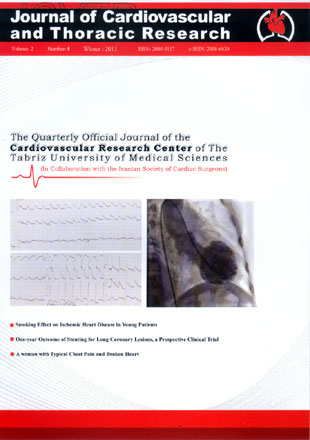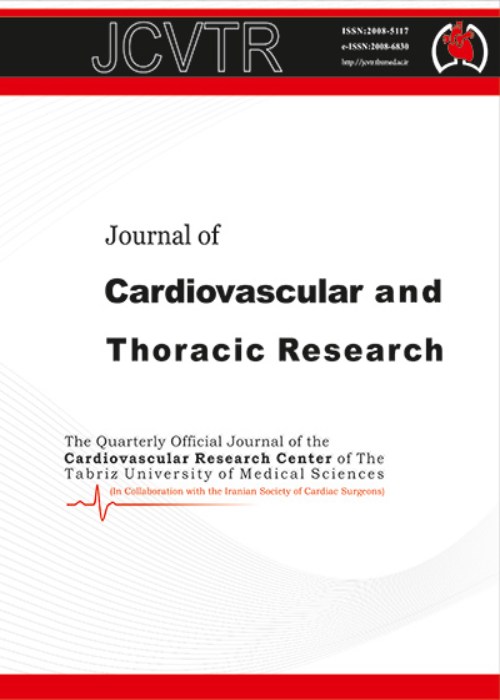فهرست مطالب

Journal of Cardiovascular and Thoracic Research
Volume:2 Issue: 4, Feb 2010
- تاریخ انتشار: 1389/11/24
- تعداد عناوین: 8
-
-
Page 1BackgroundSmoking predisposes individuals to several atherosclerotic clinical syndromes, including myocardial infarction and other acute coronary syndromes, stable angina and sudden death. Smoking can trigger myocardial infarction in individuals with minimal atherosclerosis or even with normal coronary arteries, especially among the young, promoting temporary coronary vessel occlusion, as a result of thrombus formation, coronary artery spasm or both. This study aims to evaluate the effect of tobacco smoking on the risk of ischemic heart disease (ST elevation myocardial infarction, non ST elevation myocardial infarction, unstable angina, and Prinzmetal`s angina) in young adults (≤ 45 years).MethodsA retrospective study was conducted over a 2-year Period from January 2008 to March 2010. One hundred and thirty five consecutive cases of acute myocardial infarction (STEMI and NSTEMI), Unstable angina, and Prinzmetal`s angina in young patients (≤ 45 years) who present to the emergency department (ED) of the Aleppo University Hospital, Aleppo University Heart Hospital, and admitted to the cardiovascular care unit)CCU). Data were compared between smoker patients and non smoker patients.ResultsThe mean age was 39.7±3 years (range20–45), 87.60% were males. The major risk factor was tobacco use (78.48%), followed by hypertension (23.70%), dyslipidemia (21.48%), obesity (18.51%), family history of IHD (15.55%), and diabetes mellitus (3.7%). (56.6%) of patients had a smoking as a single risk factor for ischemic heart disease without another risk factors. (59.25%) of patients had STEMI; (22.96%) had NSTEMI; (16.29%) had unstable angina; and (1.48%) had Prinzmetal`s angina. (56.89%) of patients had single vessel disease as documented by angiography; (20.68%) had tow-vessel disease, (13.79%) had three-vessel disease; and (8.62%) had normal coronary arteries.ConclusionsThe study focuses our attention on the rising incidence of acute MI in young individuals. Smoking was the major risk factor followed by hypertension, dyslipidemia, obesity, family history of IHD, and diabetes mellitus. These observations are important for primary prevention of such diseases in young individuals.
-
Page 7BackgroundPercutaneous coronary intervention (PCI) for long coronary lesions is associated with poor angiographic and clinical outcome compared with focal lesions. Here we describe our experience in PCI of such lesions with bare (BMS) or drug eluting stents (DES).MethodsBetween October 2008 and September 2009, One hundred patients with one significant coronary artery stenosis of longer than 20 mm were enrolled in this prospective study. Demographic, clinical and angiographic data were collected and the rate of ischemic events and major adverse cardiac events (MACE) were evaluated in a mean follow up period of about 11.3±3.2 months.ResultsMean age of participants was 58.08±8.97 years. Seventy two (72%) patients were male and the remainders were females. Majority of patients underwent DES implantation [25 (25%) BMS, 75 (75%) DES, P<0.001)].There was no difference in frequency of major risk factors distribution among DES or BMS groups. Mean diameter of implanted stent was 2.8±0.033mm in DES group and 2.9±0.35 in group with BMS (P=0.214). The mean length of implanted stent was 25.8±3.08mm in DES and 23.36±0.mm in BMS groups (P<0.001). In-stent restenosis rate was significantly higher in BMS group [6(24%) in BMS and 5(6.9%) in DES, P=0.02]. MACE were observed in 7(9.3%) of patients with DES and 7 (28%) of patients with BMS (P=0.04).ConclusionIn long coronary lesions implantation of DES was associated with lower MACE compared with BMS in one year follow up. Studies with longer term follow up are needed to further clarify this issue.
-
Page 13BackgroundThe oxidative stress and inflammation are cooperative events involved in atherosclerosis development. In the present study we assessed the association of MDA, antioxidant markers, high sensitive C - reactive protein (hs-CRP) and lipid status parameters in the patients with coronary artery disease (CAD). Significant risk factors such as cigarette and diabet were excluded from the study.MethodsOxidative stress parameters for example Malondialdehyde (MDA), antioxidant markers including: erythrocyte superoxide dismutase(SOD), Glutathion peroxidase (GPX), Total antioxidant capacity(TAC), The inflammation marker and serum lipid status parameters were measured in 120 subjects including 60 CAD patients with angiographically diagnosed CAD and 60 CAD-free subjects as a control group, also diabetics, smoking patients, patients with malignancy, renal and liver disease, and other disease were excluded from the study.ResultsThe serum MDA and hs-CRP levels were increased significantly as compared to controls. However, erythrocyte SOD, GPX activities and TAC level were reduced significantly in patients (P‹0.05 in all cases). The levels of total cholesterol, Triglyceride, LDL-C were significantly higher and that of HDL-C was meaningfully lower than those of control (P‹0.05 in all cases).ConclusionThe association between oxidative stress parameters, antioxidant markers, the inflammation index and lipid status parameters suggest their involvement in atherosclerosis development that may lead to CAD progression.
-
Page 19BackgroundThe aim of the present study was to investigate the effects of the left ventricular outflow gradient on tissue doppler imaging (TDI) values in patients with hypertrophic cardiomyopathy (HCM).MethodsThis prospective observational study was conducted in a tertiary referral heart hospital (Tabriz, Iran) from March 2004 to March 2008. Fifty two patients (28 men and 24 women) with definite diagnoses of HCM were selected for the study. 2D, M-mode echocardiography and TDI were performed for all patients. In TDI, the velocities of myocardium was measured at lateral and septal corner of the mitral valve annulus in peak early diastolic (Ea), peak late diastolic (Aa) and peak systolic (Sa). Then, the TDI velocities were compared in patients with left ventricle outflow gradient less and more than 30 mmHg.ResultsThe mean age of the patients was 42.13 ± 12.22 years. All patients were in New York Heart Association functional class I or II. The mean EF was 55 ± 7%. It was found that TDI velocities are reduced in patients with HCM, compared to normal vaues and Ea in septal corners of the mitral annulus was reduced more in patients with left ventricle outflow gradient > 30 mmHg (5.3±1.6 vs 7.1±1.2, P=0.01).ConclusionTDI findings specially peak early diastolic (Ea) mitral annular velocity are good parameters in HCM patients assessment
-
Page 23BackgroundLV dysfunction reflects the impairment of pumping function of the heart. Left ventricular ejection fraction (LVEF) of >50% refers to the excellent pumping condition and less than 30%, illustrates the decreased ability or even the failure. Depression is one of the most common psychological disorders. From the cognitive point of view and because depression is a widespread psychological problems in coronary patients the aim of this research is evaluation of the relation between LVEF, depression, gender and age.Methods128 patients with coronary heart disease in shahid madani heart hospital were enrolled. Data were statistics analyzed.ResultsThe results of the current study showed that a close meaningful relationship exists between gender and depression (p=0.0001) and also between gender and LVEF degree (p=0.03). other parameters such as age.ConclusionSeveral studies in both inside and outside of Iran have confirmed these results. Patients with coronary artery disease need complementary treatment such as antidepressant medication and coping with negative mood techniques.
-
Page 27BackgroundAccording to previous studies elevated blood total homosyteine has been suggested to be an independent risk factor for cardiovascular disease. The aim of this study was evaluation of homosyteine serum in smoker and nonsmoker patients with acute coronary syndrome (ACS).MethodsEighty five patients were enrolled in this study. Forty eight patients (21smoker and 27non-smoker) diagnosed with acute myocardial infarction (AMI), 37 patients (14smoker and 23non-smoker) with unstable angina (UA) that admitted in Shahid Madani Heart center in Tabriz in 2008-2009. The mean age of patients with AMI and UA were 61.83±13.78 and 59.90±11.95 years, respectively. Homocysteine serum Levels were measured by Hitachi Auto analyzer.ResultsThe mean age of patients with AMI was 61.83±13.78 years and in patients with UA was 59.90±11.95 years (p=0.53). Mean serum levels of homocysteine were not significant difference between AMI and UA patients (17.61±11.25 µmol/L vs. 22.25±12.44, p=0.78). There was also a significant correlation between high levels of homocysteine with AMI and UA diseases in comparison with normal reference values. There were not statistically significant differences in serum homocysteine levels between smoker and nonsmoker patients in both AMI and UA groups.ConclusionThe Mean levels of Homocysteine in AMI and UA groups were not significantly different. Our study showed age of smoker patients in AMI and UA groups were significantly lower than nonsmoker patients.
-
Page 31Stress-induced cardiomyopathy is an increasingly recognized syndrome characterized by transient apical or midventricular dysfunction that mimics myocardial infarction in the absence of significant coronary artery disease (CAD), but with essential difference in their management; thus our report present one of these cases.
-
Page 35In tolerance to oral anticoagulant drugs may arise as an inborn genetic defect resulting in insensitive hepatic receptor sites to oral anticoagulants or it may be due to one of several acquired causes such as noningestion or malabsorption of the drugs, simultaneous ingestion of barbiturates or the inadvertent consumption of foods with a high vitamin K content. It is an uncommon phenomenon and the genetic defect is usually not recognized until the need for oral anticoagulation arises. We report here a case of resistance to Warfarin in the hope that an awareness of this phenomenon may turn up similar case of study.


